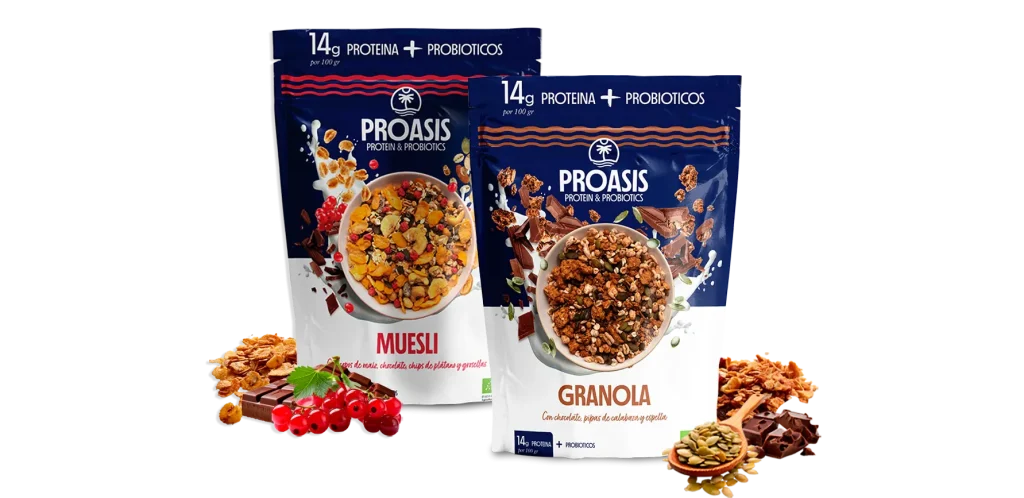A functional ice cream is much more than a traditional ice cream. Although they may look similar, there are significant differences worth noting. Our goal is that by the end of this article —and making a bold comparison— you’ll be able to distinguish them as clearly as boiled potatoes from a processed potato snack. Shall we begin?
Conventional vs. functional ice cream
Conventional ice creams share a standard composition and follow traditional production methods. Typically, they have a smooth and creamy texture and are made with ingredients like milk, sugar, and natural or artificial flavorings. They stand out for their wide range of classic and popular flavors like vanilla, chocolate, nougat, and strawberry.
Generally, they contain high levels of sugars and saturated fats, making them high-calorie products. Produced without any ice cream innovation, they lack functional ingredients or added health benefits.
While they are much enjoyed for their traditional taste, they lack specific nutritional properties and are comparable to candy: tasty, but not advisable for regular consumption.
The healthy ice cream
Functional ice creams are frozen dairy products made with added ingredients that offer specific health benefits, going beyond basic nutrition.
They are designed to promote beneficial physiological functions in the body and are formulated with truly valuable additives:
- Probiotics
- Prebiotics
- Vitamins
- Minerals
- Plant extracts
What sets this type of healthy ice cream apart are its added properties, which go beyond simple taste. In recent years, they’ve gained popularity due to the growing emphasis on balanced nutrition and awareness of the potential benefits certain ingredients offer to human health.
Key differences between functional and conventional ice cream
The main differences between functional and conventional ice creams lie in their composition, nutritional purpose, and health impact.
Here is a summary comparing traditional and functional ice creams:
|
Conventional ice creams | Functional ice creams | |
| Main purpose | Taste, pleasure, and refreshment | Nutritional value and health benefits | |
| Typical ingredients | Refined sugar, saturated fats, flavorings | Natural sweeteners, probiotics, fibers, functional proteins | |
| Nutritional value | Low, high in empty calories | Better nutritional profile, more balanced | |
| Health function | None or very little | May improve digestive, immune, and metabolic health | |
| Target audience | General, no specific focus | Consumers with specific needs (diabetics, vegans, athletes, etc.) | |
| Clean label | Not necessarily | Often yes (no artificial additives or preservatives) |
The best way to compare them is to highlight the benefits of functional ice creams against the downsides of conventional ones.
Main benefits of functional ice cream
These products offer many advantages:
- Improved digestive health thanks to probiotics and prebiotics that balance gut microbiota.
- Superior nutritional value with high-quality proteins, fewer added sugars, healthy fats, and fiber.
- Options for intolerances or special diets such as lactose-free, gluten-free, vegan, diabetic-friendly, etc.
- Metabolic and weight control with low glycemic index or ingredients that promote satiety.
- Perceived added value as they are associated with a healthy lifestyle, boosting consumer interest.
Another great advantage —especially when choosing Proasis ice creams— is the exquisite variety of flavors available. Which of these six would you try first?
- Yogurt with wild berry syrup
- Stracciatella with Belgian cocoa chips
- Madagascar vanilla with caramel
- Mango
- Chocolate with Belgian chocolate chips
- Crispy bonbon
It’s hard to say which one is the most tempting!
What are the downsides of traditional ice creams?
The biggest differences come down to the improved nutritional and compositional quality of functional ice creams. These represent the pinnacle of ice cream innovation and surpass conventional options in design, performance, and health value.
Today, with increased awareness about healthy eating, the shortcomings of traditional ice creams are more evident. Mainly:
- High in calories and sugars, contributing to obesity, type 2 diabetes, and dental cavities.
- Presence of trans or saturated fats, increasing cardiovascular risk.
- Artificial ingredients like colorants, flavorings, and preservatives that can cause intolerance or health issues.
- Low nutritional value providing empty calories without functional benefits.
- Limited dietary adaptability, making them unsuitable for people with allergies or dietary restrictions.
Ultimately, functional ice creams offer a healthier alternative suited to today’s consumers who seek pleasure without compromising health. They are also highly useful for athletes, both professional and recreational. While their price may be higher, the health benefits far outweigh the risks of conventional ice cream.
As for flavor, the Proasis functional ice cream selection is absolutely delicious — making them just as, if not more, enjoyable than traditional ones.
Research sources








